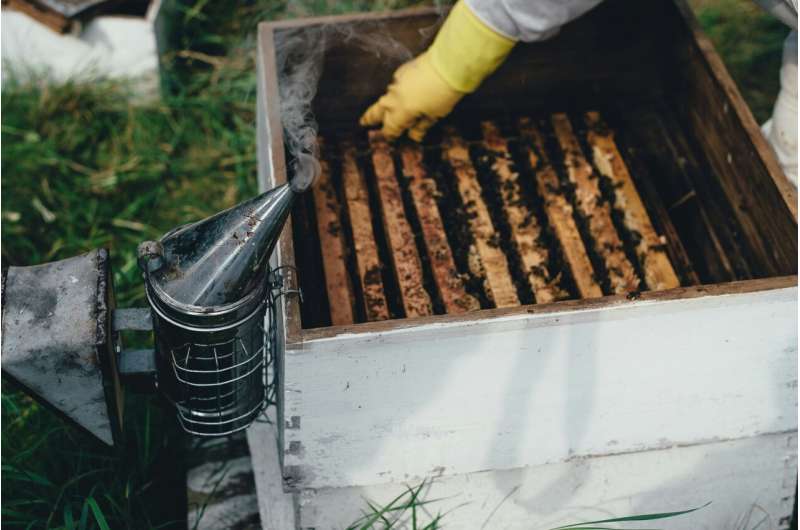This article has been reviewed according to Science X's editorial process and policies. Editors have highlighted the following attributes while ensuring the content's credibility:
fact-checked
trusted source
proofread
Combining pest treatments may be key to helping honey bees survive the winter

Winters can be tough on managed honey bee colonies, with beekeepers in the United States reporting that one-third of their colonies die each winter. A new study by Penn State researchers has found that using not one but multiple pest treatments may help bees make it to spring.
The researchers found that beekeepers who used a combination of treatments for Varroa mites—tiny parasites that can weaken and spread diseases to honey bees—had higher winter colony survival than those who used only one type of treatment. The findings were published in the Journal of Insect Science.
Additionally, while weather significantly impacted winter colony survival, beekeepers using these integrated pest management strategies—where multiple methods are used to control Varroa mites—had higher colony survival rates even in harsh weather conditions.
Darcy Gray, a global remote sensing manager at the One Acre Fund who led the study while completing her master's degree at Penn State in the intercollege Ecology Graduate Program administered by the Huck Institutes of the Life Sciences, said she conducted this study to help provide beekeepers with the locally specific information they need to make decisions about how to best manage their colonies to combat these high colony losses during the winter.
"Honey bees pollinate various crops across North America, so it's important to understand how they're influenced by beekeeping strategies and their environment, particularly under increasing weather variability," said Gray, who did her graduate research in the lab of Christina Grozinger, Publius Vergilius Maro Professor of Entomology in the College of Agricultural Sciences.
"Understanding honey bees' relationship to the environment can also shed light on and introduce new questions about native bees, which are also threatened by habitat loss and climate change."
For the study, the researchers used data from an annual survey on winter honey bee colony loss and beekeeping management that has been sent to Pennsylvania beekeepers each spring for more than 15 years.
Data included information on pre- and post-winter colony numbers, how many years of experience the beekeeper had, whether and how they treated for Varroa mites, and whether and what they provided for supplemental feed.
Beekeepers also had an option to submit their apiary coordinates, which allowed the researchers to precisely calculate the habitat quality of the landscape surrounding each beekeeper's hives—including the availability of floral resources in the spring, summer and fall—and to obtain information on the weather conditions that the bees experienced over the previous year.
Grozinger, who also directs the Penn State Center for Pollinator Research, noted that because habitat and weather are complex factors, a lot of data is needed to build statistical models for understanding exactly how they are impacting bees.
"We are so fortunate to be able to work with the Pennsylvania beekeepers, who every year answer a survey on their management practices, their bees' winter survival and their apiary locations," Grozinger said. "This provides a truly unique and valuable long term data set for this research."
The study revealed that beekeepers who used treatments against Varroa mites in their apiaries had significantly higher bee survival than those who did not, and those who used multiple types of treatments had better survival than those who used a single treatment type.
The researchers also found no significant difference between "soft" and "hard" chemical treatments. Soft chemicals—naturally derived, organic compounds—were as effective at increasing winter survival as hard chemicals, which are synthetic chemicals that have been shown to leave long-term residue in colonies and may promote populations of Varroa mites that are resistant to treatment.
These results are consistent with previous studies conducted by Penn State researchers demonstrating that organic beekeeping methods were just as effective as more conventional methods.
Additionally, the researchers found that while spring, fall and winter precipitation was associated with increased bee survival, summer precipitation was associated with decreased colony survival. The researchers suggested this could be because many consecutive days of rain in the summer may reduce the amount of time bees spend foraging, leading to less food stored for the winter and lower brood production.
"This study, along with others from Penn State, shows that the weather conditions during the growing season are really important for honey bee survival and honey production, as well as wild bee species abundance," Grozinger said. "This suggests that what we are seeing is an effect of weather on the flowering plants that bees depend on for pollen and nectar, and this in turn affects the bees."
Gray said she hopes the findings will be useful to beekeepers while planning their apiary management strategies, as well as be a springboard for future studies.
"Our work introduces new questions about how colonies treated with an integrated pest management may be buffered from the worst effects of weather, which would have implications for climate change adaptation in beekeeping," Gray said.
Beekeepers and others interested in exploring the land use and weather conditions and predicting flowering resources at their locations can use the Beescape tool on the Center for Pollinator Research website, which also offers resources on how to improve local habitats for bees, including the Penn State Master Gardener's Pollinator Garden Certification Program.
The data used in this study can be accessed via the Bee Winterwise tool, and beekeepers also can obtain resources on managing Varroa mites and organic beekeeping practices from Penn State Extension.
More information: Darcy Gray et al, Effective pest management approaches can mitigate honey bee (Apis mellifera) colony winter loss across a range of weather conditions in small-scale, stationary apiaries, Journal of Insect Science (2024). DOI: 10.1093/jisesa/ieae043
Provided by Pennsylvania State University




















